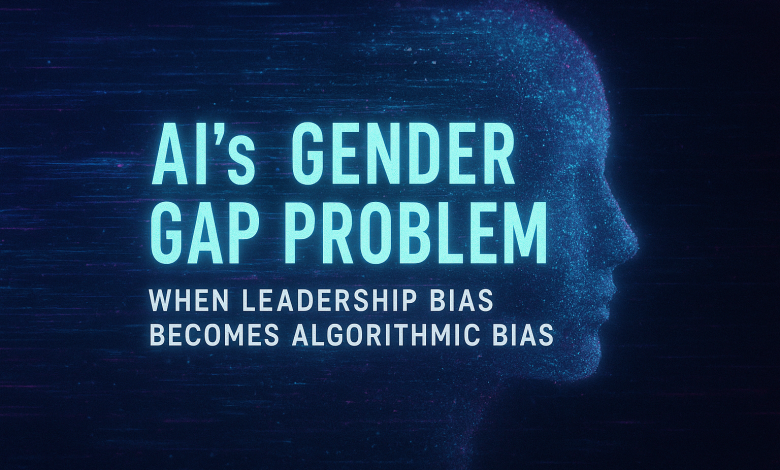
Artificial intelligence is drastically changing the way our world operates, and the people building it are quietly determining who benefits from it. Because of AI, changes are already in motion; from the way we live, work, and make decisions. And AI bias isn’t random or a glitch in the system; it reflects human decisions from the very start, influencing what data is collected, what patterns are valued, and which questions are prioritized.
According to SheTO’s 2025 The State of Women in Engineering Leadership report, only 7% of companies have a woman or nonbinary leader in the most senior engineering role. Translation: Two-thirds of companies have no women vice presidents of engineering at all and that means the vast majority of decisions shaping AI systems, from model design to deployment, are made by men, leaving women almost entirely out of the equation.
When half of the population is missing from the rooms defining the future of technology, the algorithms built to serve us all inevitably reflect that absence.
In today’s environment, asking people to build diverse teams may feel like an uphill battle, but it’s the first and most critical step toward addressing algorithmic bias in AI. When half of the population is missing from the rooms defining the future of technology, the algorithms built to serve us all inevitably reflect that absence. We’re already seeing the consequences unfold: AI-generated images that depict white men as “CEOs” and “engineers,”and hiring algorithms that reinforce gender bias. These biases don’t appear out of nowhere – they stem from a lack of diversity among the teams creating these systems.
Leadership Imbalances and Systemic Consequences
The State of Women in Engineering Leadership report found that just 15% of engineers and 14% of engineering managers identify as woman or nonbinary. Representation drops further to 9% at the director level, a structural barrier coined as “The Director Ceiling” in the report.
That drop-off is significant. Directors and senior engineers call the shots from research priorities, budget allocations, and the strategic direction of entire teams. When these roles remain overwhelmingly male, AI systems risk mirroring a single experience. Without women and nonbinary leaders influencing early decisions, organizations lose the creative and cognitive diversity to detect blind spots before it’s too late.
A Leadership Gap That Grows with Scale
The imbalance isn’t confined to startups or early-stage tech companies. As organizations grow, representation of women in engineering leadership collapses further, dropping from 17.4% in small companies to just 6.9% at the enterprise level.
This downward trend is especially concerning because large-scale AI systems are primarily developed by enterprise level organizations. In other words, the bigger and more powerful an AI company becomes, the less likely it is that women hold meaningful technical authority within it. Growth, rather than expanding opportunity, is shrinking it.
Who Gets to Define “Intelligence”
The people shaping AI hold the power to define what “intelligence” means and their decisions are far from neutral. Artificial intelligence reflects the priorities and perspectives of the people who create it. Even when women are present in the room, they’re often standing alone, without the support or sponsorship needed to ensure their voices play a pivotal role in key decisions. That lack of backing doesn’t just affect workplace culture; it seeps into the technology itself, overlooking perspectives that are essential for truly inclusive AI.
Bias can appear at any stage of development. Training datasets that overrepresent one demographic teach the model from an incomplete view of the world. During design, engineers may prioritize features or metrics that reflect their own experiences during model design.
The future of AI depends on broadening whose voices are included. Real intelligence reflects the diversity of the world, not just the small fraction that gets to lead.
The Data on What Works
Inclusion works, and the data shows a clear path forward. Companies with active DEI programs have 2.5 times more women CTOs than those without. Structured initiatives such as sponsorship programs, leadership accelerators, and employee resource groups (ERGs) create tangible career pathways that keep diverse talent in the pipeline rather than pushing them out.
A 2023 McKinsey study found that companies with a higher executive representation of women and people of color outperform less diverse companies by 39%. These findings demonstrate that diversity isn’t just ethical; it is strategic.
From Algorithmic Bias to Structural Change
Bias in AI is not a technical glitch to be debugged. It’s a leadership issue that requires structural reform. Algorithms don’t select their data or decide what fairness means, leaders do.
The leadership trends highlighted in the report point to a deeper structural issue: when decision-making power in engineering remains concentrated among men, bias stops being an accident and becomes integrated in the design. Organizations with structured DEI initiatives have shown measurable progress, proving that leadership diversity is the first step toward algorithmic fairness. Visible career advancement paths, a collaborative environment, and strong community and mentorship are pivotal steps for an organization to take for an inclusive team. Now more than ever, it’s imperative for organizations to do their part to strengthen the engineering pipeline.
The Cost of Inaction
Unchecked gender imbalance in engineering leadership risks embedding bias into systems that govern everyday life. AI tools already influence hiring processes, loan approvals, and even medical advice. Those same systems decide whose resume rises to the top, whose symptoms are prioritized, and whose opportunities are overlooked.
The danger lies in bias becoming invisible and accepted as society’s norm. Inaction now risks cementing inequality into the future of technology forever.
What Comes Next
The future of AI is still being written. The leadership decisions made today will determine whether AI perpetrates inequality or helps dismantle it. Widening the pipeline for diverse leaders and committing to structural reform isn’t optional. It’s essential for building fair, intelligent systems for all.

